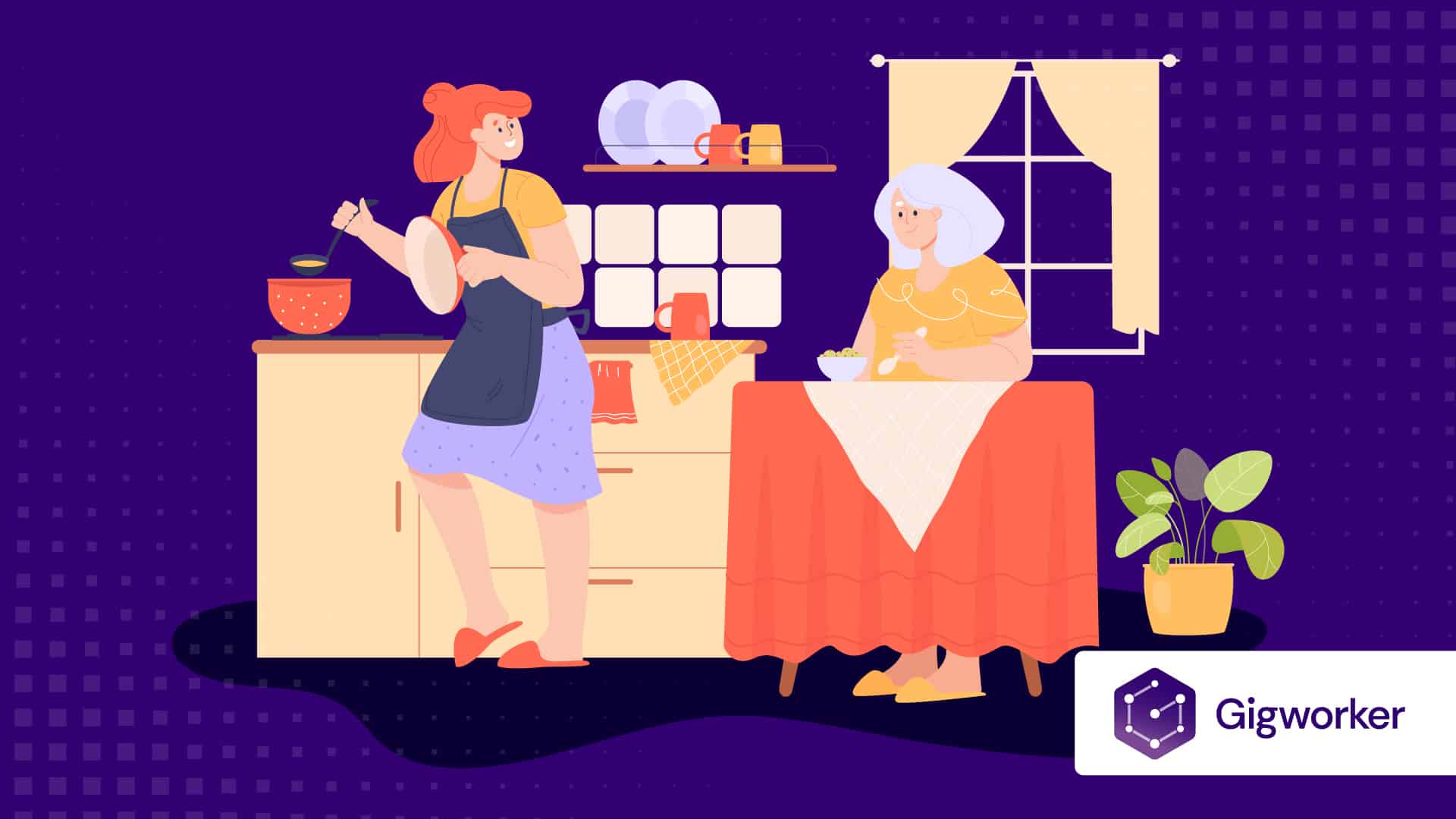Becoming a caregiver is a side hustle that is relatively uncommon. Despite that, it’s a highly underrated gig with excellent opportunities and plenty of advantages.
If you want to know how to become a caregiver for a family member but don’t know where to start, this guide will have you covered with all the information you need to know.
Keep on reading for a brief guide with everything you need to know about becoming a paid family caregiver. Let’s dive right in!
- An Overview of Caregivers for Family Members: A Primer
- What You’ll Need to Become a Caregiver for Family Member [& Associated Costs]
- Is it Hard to Become a Caregiver for a Family Member?
- How to Become a Caregiver for Family Member in 5 Simple Steps
- Reasons to Consider Becoming a Caregiver for Family Member
- Frequently Asked Questions
- Similar Gigs to Check Out
- Wrapping Up
An Overview of Caregivers for Family Members: A Primer
A family caregiver is a term describing an individual providing personal care for a member of their loved ones. This is mainly family members but can also be neighbors, relatives, close friends, community members, etc.
In other words, they’re informal caregivers that differ from regular caregivers that provide their services professionally. A caregiver provides assistance in various aspects, such as:
- Performing domestic tasks, such as household chores, buying groceries, and preparing meals.
- Providing assistance to disabled family members, such as toileting, exercising, bathing, dressing up, etc.
- Carrying out basic therapeutic and medical tasks, such as preparing and scheduling medications.
How Much Do Caregivers for Family Members Make?
Ideally, a family caregiver is a volunteer job, so you don’t get paid for doing it. However, there are several programs that offer financial support to family caregivers.
On the other hand, professional personal care aides can earn around $14.15 per hour or $29,430 per year.
According to Genworth, the median monthly cost of a live-in caregiver in 2021 was around $4,957 to $5,148.

What You’ll Need to Become a Caregiver for Family Member [& Associated Costs]
The specific requirements for an informal caregiver may vary depending on your location, but they typically include:
- High School Education: While there isn’t a specific education necessary for the job, a GED or high school diploma is often the minimum requirement to be a family caregiver.
- Physical Ability: A family caregiver is one of the jobs that require working overnight and providing assistance to physically impaired individuals.
- Medical Training: Providing medical care may require some form of training. These range from mandatory free courses to proper training that costs up to $200.
- Eligibility Certificate: In some locations, qualifying for family caregiver compensation requires earning an eligibility certificate. It can cost around $100 to obtain.
How Much Does it Cost to Become a Caregiver for a Family Member?
One of the main perks of being a caregiver for a family member is that you don’t need any special licenses or education to practice it.
The overall cost to become a caregiver ranges from free to $300 – $500. You can find out more about the exact costs by checking with local authorities about eligibility requirements where you live.
Is it Hard to Become a Caregiver for a Family Member?
Becoming a caregiver is a fairly easy process because you typically don’t need any special licenses or training to qualify as a family caregiver.
However, providing assistance for another person, especially an older adult or physically challenged person, can be quite exhausting and demanding.
How Long Does it Take to Become a Caregiver for a Family Member?
A caregiver for a family member rarely needs any formal education or training to perform their roles. For that reason, you can become a family member’s caregiver within a short period.
If you need training to provide medical assistance, the courses may take up to two to three months. However, you can typically attend after carrying on with the responsibilities of a family caregiver.
How to Become a Caregiver for Family Member in 5 Simple Steps
Providing family caregiver support is a fairly unique gig with special circumstances. For that reason, becoming one has a unique pathway. Here’s a simple guide to show you how to start.

1. See If Your Family Member is Eligible for a Family Caregiver Support Program
Self-directed services is a program by Medicaid that allows participants and their caregivers to receive financial support in most states.
The program helps eligible individuals pay for goods and services necessary for their personal care needs. In many cases, enrollees can spend these funds to pay for a caregiver for a family member.
The program offers a variety of options to provide enrollees with financial support. The monetary support and the conditions of each program may vary from one state to another.
You can check if your loved ones are eligible for any of these programs by contacting the local Medicaid office.
2. Enroll in the Suitable Support Program
If your family member or loved one is eligible for respite care programs offered by Medicaid, you need to pick the right one. For instance, 1915(i) -“Home and Community Based Services State Plan Option”, includes payments for caregivers for family members.
This program offers various forms of financial support for personal care providers. It also provides coaches for guidance and tax-free stipends.
The terms of the HCBS program vary from one state to another, so you need to check the state’s website for more information about it depending on where you live. The duration of this support program may also vary, but most states provide it up to five years.
3. Check Your Family Member’s Insurance Coverage Policy
Caregivers for family members can also check the insurance policy of their loved ones and their compensation options. Some long-term care plans may include financial aids to pay for a personal caregiver or family member providing care.
The easiest way to check if such a compensation option exists is to contact a representative of the insurance company for clarification.
While you’re at it, you should also ask about any other forms of insurance benefits that involve personal caregivers.
In some cases, you might need to provide documents related to caregiving, such as out-of-pocket expenses (to receive reimbursements). That’s why it’s a good idea to keep records of all these payments to submit them if you have to.
4. Check for Additional Programs and Benefit Options
Besides Medicaid programs, there are other resources to look into if you’re a caregiver for a family member. One of the prime examples here is the Veteran Directed Care Program.
This program allows veterans to continue living in homes and engage in community life instead of institutionalization.
Like other human service programs, the eligibility conditions and compensation may vary from one state to another. You can check the Administration for Community Living (ACL) to find out more about this program for each state.
If you already have a job, you can receive payments while providing care for your family member through paid leave.
Family leave is a relatively new form of paid leave, and it’s not mandatory by the government. For that reason, not many companies and businesses include them as a work benefit.
Checking with the company’s HR department is the best way to find out more about this option.
5. Obtain Financial Assistance for Family Caregivers
If your family member doesn’t qualify for any of the previous programs, you’re not out of options.
You can still get paid for your services in various other methods. For instance, by getting paid directly by your family through a personal care agreement.
Some people may find getting payments directly from their family members a bit uncomfortable. Yet, it’s always an option available when other solutions aren’t, and makes the financial burden of caregiving much easier to bear.
The Family Caregiver Alliance recommends hiring an elder law attorney to draft a proper agreement in writing. This can also be a valuable asset in case any of the previously mentioned options become available later on.
Reasons to Consider Becoming a Caregiver for Family Member

Working in the personal care services industry has plenty of advantages. Here are some of the main reasons to consider this career:
- Sense of Accomplishment: Providing care to your loved ones will help you feel accomplished and satisfied all the while getting paid to care for parents.
- Personal Development: Working as a caregiver gives you a unique perspective on life and teaches you many skills that you can apply to your personal and familial relationships.
- Scalability: If you’re interested in pursuing a career as a caregiver, you can start a home care business. Additionally, you can use your experience to apply for gig jobs on on-demand care apps like Papa elder care.
- Medical Field Experience: Are you planning to pursue a career in the medical field? Becoming a caregiver can help you gain a lot of valuable experience that stays relevant later on.
Frequently Asked Questions
New family caregivers usually have many questions in mind. Here’s a quick look at some of them.
What State Pays the Most for Family Caregivers?
The State of Washington is currently the one that pays the most for a caregiver for a family caregiver.
According to a report by ZipRecruiter, the average annual salary of a live-in caregiver in Washington is $57,925. The hourly pay is also the highest at $27.85.
However, you should note that this figure doesn’t necessarily reflect other aspects like the cost of living.
Are Caregivers in Demand in the United States?
A caregiver is in incredibly high demand in the United States as well as North America in general.
This is because of high living standards and high life expectancy, so there are plenty of seniors that require special care. In fact, the BLS expects the job demand to grow by 25% by the end of 2031.
Similar Gigs to Check Out
If you don’t find a family caregiver a suitable job for you, these gigs can be a suitable alternative.
- How to Become a Nanny: A nanny provides assistance to parents while caring for children.
- How to Become a Babysitter: A babysitter is responsible for taking care of children while the parents/original caregivers are away or unavailable.
- How to Become a Travel Nurse: A travel nurse shares a lot of similarities with family caregivers. The main difference is that travel nurses are more specialized when it comes to those who need medical care.
Wrapping Up
There you have it! A brief guide that shows you how to become a caregiver for a family member and get paid for your services.
The best thing about this gig is that it mostly doesn’t require any special training or additional costs to start.
It also comes with both financial and personal advantages, and you can transfer your skills to establish a home care business of your own!






